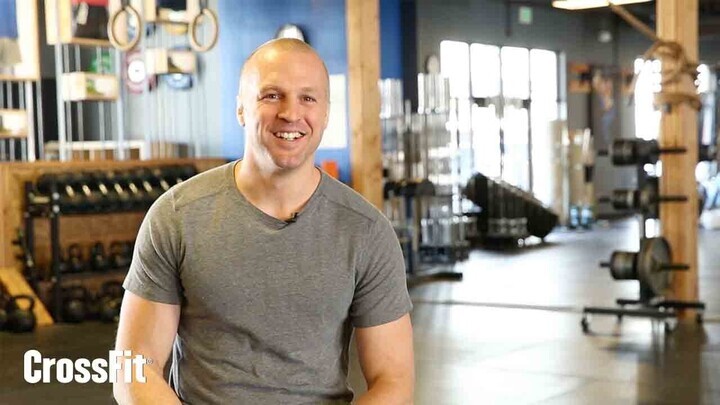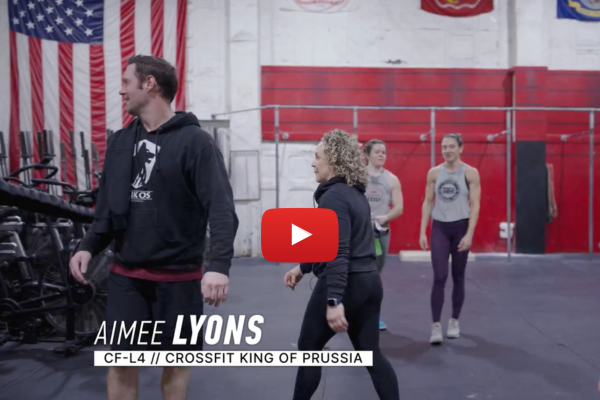Coaching aging athletes requires a thoughtful and adaptive approach to ensure workouts are accessible, effective, and engaging while preserving the spirit of CrossFit.
We recently caught up with Aimee Lyons (CF-L4), a 15-year affiliate owner, as she coached a class of aging athletes (ages 40-75) at CrossFit King of Prussia. While the class follows the same principles as a traditional group class, subtle adjustments are tailored to the athletes. Watch the full class and then read below for the breakdown and consider how you might apply these concepts to your own coaching.
Class Breakdown
Eric O’Connor: Aimee, the class workout for aging athletes you coached was a 21-15-9 of ski, toes-to-bar, wall balls, and pull-ups. Do you remember what the regular class workout was?
Aimee Lyons: Yes! The original workout was a bit more complex:
All for Time:
2 rounds of:
21 toes-to-bars
21 wall-ball shots
2 rounds of:
15 chest-to-bar pull-9ps
12/15-calorie ski
2 rounds of:
9 toes-to-bars
9 chest-to-bar pull-ups
9 wall-ball shots
9-calorie ski
Eric: Why did you choose a different prescribed workout for this class?
Aimee: I modified the workout primarily to simplify it. Our aging athletes often perform better with straightforward structures, as overly complex workouts can lead to confusion and take up too much explanation time at the whiteboard. The volume was similar to the original, but I focused on making the format easier to follow while still maintaining the workout’s intended stimulus.
Some workouts I modify for simplicity, while others stay the same with only adjustments to load or volume. However, I always aim to preserve the movement function and intent of the original workout. Our aging athletes still work on higher-level skills like bar and ring muscle-ups, but we tailor the approach to meet their needs.
Key Takeaway: Simplify complex workouts for aging athletes while retaining the intended stimulus and movement function.
Scaling
You’ll see a variety of scaling options in action, including rep reductions, single-limb work, movement substitutions like single-arm dumbbell thrusters for wall-ball shots, reduced range of motion, banded pull-ups, ring rows, multiple hanging toes-to-bar variations, lying toes-to-bar modification, and more.
Scaling in the Warm-Up
From the start of the general warm-up, you’ll notice scaling options being implemented right away. Aimee thoughtfully prepares scaling variations for each step of her teaching progressions, ensuring every athlete stays engaged and successful. This proactive approach is key to maintaining group cohesion during skill progressions.
Eric: I noticed you collaborated with some athletes on their scaling options. Is this a typical approach for you?
Aimee: Absolutely. Each athlete is unique, especially in a class with people aged 40 to 75, where many have injuries or conditions to consider. I come in with a plan but collaborate with them to ensure the scaling is appropriate. This approach differs from regular classes because these athletes often need adjustments beyond load and volume.
Collaboration also plays into human psychology. When athletes have a say in their scaling, they feel more invested and motivated. I also vary the scaling options to keep things engaging and fresh.
Key Takeaway: Collaborate on scaling options to personalize the experience and boost athlete investment and motivation. For more on scaling, check out our online scaling course.
Demonstrations
In the video, you’ll notice Aimee often has her athletes demonstrate movements, particularly those who are skilled at the task. She finds this approach not only excites and inspires the class but also fosters post-class conversations and collaboration, as advanced athletes share tips with newer ones. Aimee uses this strategy in both regular classes and those with aging athletes, showcasing what athletes can achieve at any age while keeping the environment engaging and supportive.
Eric: During class, you had some of the athletes demo movements. Is this something you do often, and does it differ from your approach in a regular class?
Aimee: I love having aging athletes demo, especially when I know they’ve mastered the skill. It gives them a chance to shine and inspires others to work toward similar achievements. It often sparks post-class conversations about how they developed that skill, which builds camaraderie.
I do this in regular classes as well, but it’s particularly rewarding in these classes. It’s a great way to remind them — and everyone — that they’re capable of incredible things, regardless of age. And let’s be honest, I can’t always jump into a bar muscle-up cold anymore — haha!
Key Takeaway: Highlighting skilled athletes as movement demos inspires confidence and encourages camaraderie within the class. To learn how to do more effective demonstrations, register for your Level 2 Certificate Course.
Instructional Waves
Watch the toes-to-bar instruction from 23:30-28:40, and focus on how Aimee manages the group through the repetitions in what she calls moving the athletes in “waves.” She likes to have one to three athletes move simultaneously when working on higher-skill pieces of a progression.
Eric: For the toes-to-bar progression, you had them go in waves, focusing on one or two athletes at a time. Is this something you try to do in regular classes as well?
Aimee: Definitely. I like moving athletes in waves during skill work, whether it’s a class specific to aging athletes or a regular class. This allows me to give individualized attention while the rest of the group observes and learns. It also creates opportunities for on-the-spot feedback that benefits everyone listening.
Starting with larger waves and narrowing to smaller groups as the progression advances works well. For example, I might initially split the class in half, then into thirds, and eventually down to individuals. This ensures every athlete gets focused coaching without feeling overwhelmed.
Key Takeaway: Use wave-based progressions to focus on individual athletes while maintaining class engagement and shared learning.
Teaching, Seeing, and Correcting
Aimee employs smooth, efficient teaching progressions where each step builds on the previous one, mirroring the expectations of a traditional group class. Throughout the workout, she identifies faults and provides concise, actionable cues while affirming improvements when appropriate. By effectively triaging faults, she focuses on the most critical issues, addressing key mechanics without overwhelming the athletes.
Key Takeaway: Use progressions when possible and use as few words as possible when giving cues and corrections. To learn how to see and correct more effectively, register for your Level 2 Certificate Course.
Homework
Experiment with one of the following strategies in your classes this week:
Athlete Demonstrations
Have a couple of athletes demonstrate aspects of your teaching progression. When you do this, note the response and whether you believe it was positive for that individual and the class as a whole.
Collaborate on Scaling
If you are an individual who likes to just tell your athletes exactly what they are doing, experiment with collaborative scaling by asking what their thoughts are on what weight to use, what movement substitution to implement, etc. Keep note of the effectiveness and if you thought it was a positive experience for that athlete.
Run a Skill Progression in “Waves”
Try implementing the “wave” strategy Aimee used for the toes-to-bar progression by having a small number of athletes move at the same time. Keep note of aspects like:
- Were you more effective with teaching, seeing, and correcting?
- Did the class benefit from a specific cue that you gave to someone?
- Did the athletes focus on the task at hand improve?
- Did it derail your time management?
You can elevate your ability to serve aging athletes by incorporating these techniques into your classes. Simplifying workouts, tailoring scaling through collaboration, highlighting athletes with demonstrations, and using wave-based progressions all contribute to a more inclusive and effective training experience. Experiment with these strategies in your own classes to build confidence, engagement, and progress for all athletes, regardless of age.
Would you like more resources on coaching aging athletes? Check out our Coaching the Aging Athlete online course here or watch this interview we did on coaching aging athletes with Dustin Jones here.
about the author
 Eric O’Connor is a Content Developer and Seminar Staff Flowmaster for CrossFit’s Education Department and the co-creator of the former CrossFit Competitor’s Course. He has led over 400 seminars and has more than a decade of experience coaching at a CrossFit affiliate. He is a Certified CrossFit Coach (CF-L4), a former Division 1 collegiate wrestler, and a former CrossFit Games athlete.
Eric O’Connor is a Content Developer and Seminar Staff Flowmaster for CrossFit’s Education Department and the co-creator of the former CrossFit Competitor’s Course. He has led over 400 seminars and has more than a decade of experience coaching at a CrossFit affiliate. He is a Certified CrossFit Coach (CF-L4), a former Division 1 collegiate wrestler, and a former CrossFit Games athlete.

How to Effectively Coach Aging CrossFit Athletes: A Full Class and Q&A with Aimee Lyons